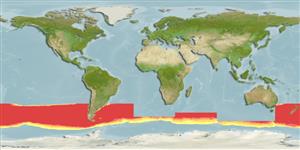Teleostei (teleosts) >
Lampriformes (Velifers, tube-eyes and ribbonfishes) >
Lampridae (Opahs)
Etymology: Lampris: Greek, lampros = light (Ref. 45335).
Environment: milieu / climate zone / depth range / distribution range
Ecology
Marine; pelagic-oceanic; depth range 50 - 485 m. Temperate; 34°S - 69°S
Circumglobal in the southern hemisphere between 34°S and the Antarctic Polar Front.
Size / Weight / Age
Maturity: Lm ? range ? - ? cm
Max length : 110 cm TL male/unsexed; (Ref. 6475); max. published weight: 30.0 kg (Ref. )
Feeds on krill, squid and fishes.
Life cycle and mating behavior
Maturity | Reproduction | Spawning | Eggs | Fecundity | Larvae
Gon, O., 1990. Lampridae. p. 215-217. In O. Gon and P.C. Heemstra (eds.) Fishes of the Southern Ocean. J.L.B. Smith Institute of Ichthyology, Grahamstown, South Africa. (Ref. 5188)
IUCN Red List Status (Ref. 130435)
Threat to humans
Harmless
Human uses
Tools
Special reports
Download XML
Internet sources
Estimates based on models
Preferred temperature (Ref.
123201): 1.8 - 11.9, mean 6.1 °C (based on 287 cells).
Phylogenetic diversity index (Ref.
82804): PD
50 = 1.0000 [Uniqueness, from 0.5 = low to 2.0 = high].
Bayesian length-weight: a=0.01995 (0.00906 - 0.04395), b=3.01 (2.83 - 3.19), in cm total length, based on all LWR estimates for this body shape (Ref.
93245).
Trophic level (Ref.
69278): 4.4 ±0.70 se; based on food items.
Resilience (Ref.
120179): Medium, minimum population doubling time 1.4 - 4.4 years (Preliminary K or Fecundity.).
Fishing Vulnerability (Ref.
59153): High to very high vulnerability (66 of 100).
Climate Vulnerability (Ref.
125649): Moderate to high vulnerability (45 of 100).
Nutrients (Ref.
124155): Calcium = 17 [8, 32] mg/100g; Iron = 0.355 [0.199, 0.637] mg/100g; Protein = 21 [17, 24] %; Omega3 = 0.636 [0.334, 1.270] g/100g; Selenium = 17.9 [8.9, 35.6] μg/100g; VitaminA = 12 [3, 54] μg/100g; Zinc = 0.322 [0.219, 0.489] mg/100g (wet weight);
